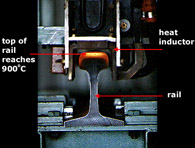
Durable heavy rail technology
1982
steel sleepers, fasteners and hardened rails
Mine railways all over the world are usually long, busy, winding and heavily loaded, and suffer extremes of temperature. Wear on the rails is a serious problem. They split and crack, and the top surface peels away in layers.
Steelmaker BHP faced all these problems in its own operations. Its iron-ore mine railways in the Pilbara area of Western Australia carry over 20 million tonnes of ore a year. During the 1970s BHP's Whyalla plant developed technology to manufacture steel rails hardened on the top ('head-hardened') to overcome wear and tear. The top of the rail is heated to 900 degrees and then quickly cooled, creating a finer structure of crystals in the steel at the top of the rail than in the base.
BHP also introduced newly designed steel sleeper sections and fasteners to attach the rail to the sleeper. The Wilclip fastener includes a unique insulation pad to accommodate rail track circuitry.
BHP's first head-hardening production line opened in 1982, and today the company manufactures 30 000 tonnes of rail a year. The head-hardening process has been licensed to American companies along with special technology for welding the sections of rail together.
Who Did It?
Key Organisations
BHP Melbourne Research Laboratories : R&D, design
BHP Long Products Division : manufacture
Key People
Dave Griffiths : metallurgist
Further Reading
'Hard heads win US business'
Unnamed author
BHP Review, December 1985.
Links
BHP Institute
of railway technology
ATSE
Technology in Australia 1788-1988
BHP
Institute for Steel Processing and Products
Related Innovations
Froth floatation process
Casting thin sheet steel
|










